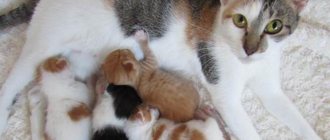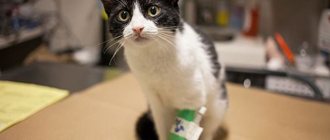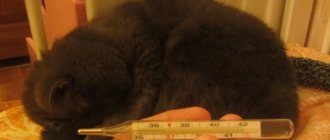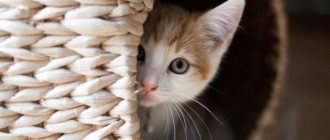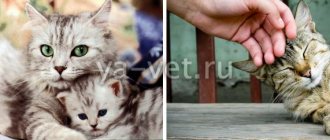General information about pregnancy in Bengals
After the mating season, which for this breed lasts from five to eight or nine days (cats successfully become pregnant, according to statistics, in 90 percent of the total number of matings), the time comes to bear offspring. Special blogs offer descriptions of how a cat’s appearance changes from week to week in pictures.
Is your cat pregnant or is she imagining it?
After lovemaking, fertilization may occur, but it may turn out to be a false pregnancy. One of the reasons for the phenomenon is sterile sexual intercourse. At the same time, a false pregnancy, like a real pregnancy, is accompanied by the same initial symptoms. Estrus stops (a rather indirect indicator), behavior changes:
- the animal loses its appetite, which is soon restored with double force;
- the cat becomes cautious, usually moves less, lies more calmly;
- slightly, but the mammary glands still swell.
After the period of imaginary pregnancy, the female prepares for childbirth and worries about the “nest.” There is no point in dissuading the animal - we must allow her to make all the preparations. Usually, after a week, the failed mother calms down and the signs disappear on their own.
Diagnostics
Even before an enlarging belly is visualized, pregnancy in a Bengal cat can be diagnosed not only by the signs listed in the previous section. Moreover, you should not rely only on the changed behavior or psychological state of the expectant mother. When diagnosing pregnancy, all these are secondary signs. For example, very young “ladies” can continue to frolic, being in an “interesting” position. Veterinary science has more definitive evidence indicating that fertilization has occurred. The clinic specialist relies on external examination (palpation), laboratory tests, and ultrasound.
Palpation of the peritoneum
Palpation can be carried out not only by a veterinarian, but also by the cat owner himself. For convenience, place the pet on the table, calm it down by scratching it behind the ear or stroking it. Then, placing your palms on both sides of the spinal column, you need to carefully and slowly bring them together under the lower back. Having knowledge, some experience, as well as good tactile sensitivity, you can feel a nut-sized formation next to the ampoules of the uterine horns 3-4 weeks after mating. In the later stages, the embryos are also palpated, and even later you can feel the movement of the fetuses inside the abdomen.
Tests and ultrasound
Blood and urine testing of Bengal cats is carried out in the laboratories of veterinary clinics. The birth of a new life and subsequent development in the womb are processes that cause strong changes in the body. They are recorded by analysis of the physical and chemical parameters of the cat’s biological fluids.
The ultrasound method is based on recording the fetal heartbeat with a device and direct visualization of kittens inside the uterus. At the examination site, the cat's hair is trimmed to make the scanner easier to move.
Bengal women with fair skin may experience pregnancy pigment spots in the mammary glands. This is due to the large amount of placental hormones wandering through the blood. After an increase in volume, a visible change in the configuration of the abdomen, the milk bags swell so much that with light pressure, a whitish liquid emerges from the pinkish nipples - colostrum.
In later stages, the female, experiencing pressure from the enlarging uterus on the bladder, often visits the toilet.
Breeding
If you decide to start breeding real purebred Bengals, you should remember that these animals will require a lot of attention. To avoid various problems, you should learn some of the intricacies of this process. Breeding Bengal cats has its own characteristics and difficulties, the most important being the slow increase in gene set. To obtain a new line of Bengal cats, many breeders have to take the very rare species Felis Bendalensis in the world. To obtain F1 and F2 mestizos, only representatives of the Bengal breed are used. This method, which has been used for many years, helps speed up the process of domesticating the wild little leopard. By all standards, to confirm that it belongs specifically to domestic cats, an animal must be four generations removed from its wild ancestor.
Bengal cats cannot be mated with domestic animals of a different breed. The result will be disastrous. Your mixed breed will not receive a worthy pedigree, and the descendants may display traits of other breeds.
Basic information about the characteristics of fertilization that lead to problems
As veterinary medicine has established, the stage of a cat's reproductive cycle (estrus) occurs in a special way. The time of ovulation, that is, the release of an egg in search of a sperm into the abdominal cavity, in cats occurs after, and not before mating. Not all eggs mature at the same time, but remain capable of fertilization for 12-48 hours. In this case, sperm inside the female’s body can be viable for 4-5 days. Therefore, embryos in the womb may develop with some lag from one another - the duration of gestation, therefore, may fluctuate. Moreover, if a cat walks uncontrollably, then already being pregnant, she can conceive again (scientific definition of superfetatio, additional fertilization, superfetation). There are known cases where a low level of progesterone provokes estrus in an already pregnant cat. As a result, new sexual activity will be triggered between the third and sixth weeks. An additional pregnancy cannot be ruled out if the groom is nearby. Then problems cannot be avoided - either one of the litters will die, or the cat will give birth again after a few weeks of full-term second kittens. It will be difficult for such a mother to feed and raise many children on her own. So it is better to monitor your pet during the period when she becomes pregnant.
Where to buy, price
Bengal kittens should only be purchased from official nurseries; this will protect you from many troubles. If you make a purchase from dubious breeders, then there is a chance of purchasing a sick or purebred animal. When purchasing, you must check the pedigree and vaccination records.
The thing is that Bengal cat kittens up to 6 months old do not look at all like adults, but like the simplest yard “Vaskas” and “Murkas” and they can slip you an outbred animal that is simply similar in color. Prices for Bengal cats are very high and range from 35,000 to 50,000 rubles
. It all depends on the pedigree, color and class of the cat. The most expensive animals are show-class kittens. Fluffy babies from random mating can be bought for 10,000-12,000 rubles, but no one here can guarantee good health and high qualities of the breed.
No matter what color your pet is, Bengals always attract the attention of others. These are kind, strong and smart cats that will become your faithful and devoted friends. Good luck to you and your furry friend!
Course of pregnancy
The duration of the period from mating to the birth of kittens is from 64 days (that’s nine weeks plus or minus two to four days). Now there is such an Internet feature as a pregnancy calculator. This calendar also applies to the Bengal cat breed. However, the birth calculator may not “guess” how long pregnancy lasts in cats, since it is impossible to accurately determine on which day of the love date fertilization occurred. Bengal litters are small - no more than five kittens, more often - from two to four. All these weeks of natural physiological state require special attention.
Food for a pregnant Bengal cat
By the end of the second week of gestation, the cat begins to eat intensively, significantly exceeding the daily norm. But you should not increase the norm in the first weeks by more than 10%. You need to give food more often - your pet has a small stomach, and digestion is difficult due to the growing uterus. Owners need to take a closer look at the balance of the food offered. The best thing to do is to purchase special dishes for a pregnant Bengal cat. The amount of necessary vitamins and microelements in such industrial products is ideal, calculated by specialists. With natural feeding, the expectant mother needs, like people, more calcium in the first weeks (fermented milk products), more protein in the second half of the term. It is unacceptable to forget about supplements containing microelements. You should not overfeed so that the cat does not become obese and the kittens are not too large - this will significantly complicate the birth. Starting from the seventh week, a pregnant woman eats less, and if she begins to refuse food, childbirth is approaching. Complete nutrients necessary for the proper development of the fetus and proper feeding are the key to healthy offspring.
What does it look like
Photo: this is what a Bengal cat looks like
Bengals are distinguished by their special grace and unusual shine of their fur. They combine the wild nature of their ancestors and the friendliness of a domestic cat.
Thanks to this friendliness, they are able to make friends with other pets living in the apartment, even getting along with a dog.
They are not alien to the features of other representatives of the cat family:
- communication and games with the owners,
- trust and responsiveness,
- curiosity and observation,
- communication in one’s own language, the ability to make sounds of different tones.
There are also distinctive features that distinguish this breed:
- love of water and bathing: when a Bengali sees a bath of water, he will immediately jump into it,
- ability to get accustomed to using a home toilet,
- desire to get the owner's attention,
- lack of aggression.
Preparing a Bengal cat for childbirth
In addition to such tasks for the period of gestation of kittens as providing a complete diet, vitamins and peace of mind, owners must take care of the physical activity of their pet and access to fresh air. It is necessary to ensure that she is not injured or overtired.
Organization of a maternity nest
Towards the end of the nine-week period, it is time to provide a place for birth - instinctively, the Bengal will definitely look for a nest for her cubs in the last week or even two. A closed cardboard box with a hole and holes for ventilation is best suited for a Bengal cat. It is important that she recognize this place as suitable in advance, and not look for another, more inaccessible one. You should lay a diaper on the bottom, and prepare several soft natural sheets in reserve.
A Bengal cat gives birth independently and calmly, usually without complications. However, in case of problems that occur with firstborns, it is worth enlisting the support of a veterinarian, an experienced breeder or an amateur who has already delivered a cat.
Bengals usually have two to four babies in a litter (the record is 6), the weight of newborns is approximately 80 to 130 grams. Cats of this breed are caring, intelligent mothers. How many times a year a cat gives birth is decided by the owner. But without harming the health of the animal, once every 10-12 months is enough. It is important for the owners to provide the right conditions - then there will be no problems with pregnancy or childbirth, and the reproductive period of Bengal cats will be quite long - cases have been recorded when the female gave birth to offspring at a very advanced age.
Read all about the Bengal breed in the Main article
If the kitten is not gaining weight well
Next, we will talk to you not about a tiny newborn pet, but about one that has already reached three months of age. So, if the owner has acquired a Bengal cat, and it is not gaining its body weight well or, on the contrary, is losing it, what to do?
In principle, Bengal cats are always healthy and beautiful. If you treat your new family member responsibly, then problems with his weight, height and health should not arise.
Among the huge number of cat breeds, the Bengal stands out especially. After all, the Bengal cat has a noble appearance, a unique character and a high ability to learn. You can learn about all the subtleties in caring for Bengal cats, their character traits, health and maintenance from our article.
Features of maintenance and care
Nothing fancy is required. However, there are some nuances that will help your pet feel happy and satisfied with life.
First of all, make sure that you have enough free space for your cat to play actively. Otherwise, the animal will be uncomfortable, it will be sad and even sick.
Now about the tray. If it is in the wrong place, the filler is not suitable (compressed wood is better, because Bengals love to dig in sand/sawdust).
Therefore, choose a tray in advance so that its sides do not allow the filler to fly beyond its limits.
Don't forget to keep it clean. If there is a smell from the litter box, there is excrement or another cat has left. But you shouldn’t wash it with chemicals either.
Otherwise, your Bengal cat will not smell its own scent and will perceive this litter box as a toilet.
The coat is easy to care for. Its healthy shine depends on a balanced and high-quality diet. There is no need for combing, but your pet is unlikely to refuse stroking its back with a soft brush.
And don’t worry about bathing, the animal will happily jump into the bath with you.
Be sure to purchase a scratching post. From childhood, accustom your baby to it, otherwise your pet will spoil the furniture and wallpaper.
By the way, even after trimming his claws, a Bengal will not refuse to sharpen them. Be alert.
